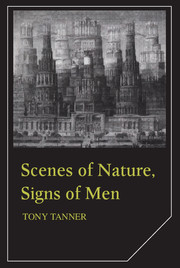Book contents
- Frontmatter
- Contents
- Preface
- 1 Scenes of nature, signs of men
- 2 Notes for a comparison between American and European Romanticism
- 3 Problems and roles of the American artist as portrayed by the American novelist
- 4 James on Hawthorne
- 5 The lost America – the despair of Henry Adams and Mark Twain
- 6 Henry James and Henry Adams
- 7 William Dean Howells and A Hazard of New Fortunes
- 8 Stephen Crane
- 9 The Bostonians and the human voice
- 10 Games American writers play: ceremony, complicity, contestation, and carnival
- 11 Toward an ultimate topography: the work of Joseph McElroy
- 12 Frames and sentences
- 13 William Gass's barns and bees
- Index
1 - Scenes of nature, signs of men
Published online by Cambridge University Press: 01 June 2011
- Frontmatter
- Contents
- Preface
- 1 Scenes of nature, signs of men
- 2 Notes for a comparison between American and European Romanticism
- 3 Problems and roles of the American artist as portrayed by the American novelist
- 4 James on Hawthorne
- 5 The lost America – the despair of Henry Adams and Mark Twain
- 6 Henry James and Henry Adams
- 7 William Dean Howells and A Hazard of New Fortunes
- 8 Stephen Crane
- 9 The Bostonians and the human voice
- 10 Games American writers play: ceremony, complicity, contestation, and carnival
- 11 Toward an ultimate topography: the work of Joseph McElroy
- 12 Frames and sentences
- 13 William Gass's barns and bees
- Index
Summary
In this manner, they proceeded along the margin of the precipice, catching glimpses of the placid Otsego, or pausing to listen to the rattling of wheels and the sounds of hammers, that rose from the valley, to mingle the signs of men with the scenes of nature.
(The Pioneers)The distinction between scenes and signs is made very clearly here, and it is invariably clear in the work of James Fenimore Cooper. The opposition is static, even dichotomous, for although the scenes and signs ‘mingle’ they so not merge into a new unity or a third term. Nor do they problematize each other as they do in later American writers for whom it is often not clear to what extent scenes have become signs, and vice versa, if indeed the two can be distinguished and differentiated. In Cooper the opposition is not without attendant ambiguities and it is often these ambiguities which give thematic energy to Cooper's work; but the terms do not lose their distinctness. The scene may succumb to the sign, or it may outlast it, but it is always clear which is which; there is no peripheral contamination of the categories. Scenes are, primarily, to be seen – appreciated by the non-intervening eye – and there are many passages in Cooper where the narrative effectively comes to a halt while a static scene is ec-statically seen.
- Type
- Chapter
- Information
- Scenes of Nature, Signs of MenEssays on 19th and 20th Century American Literature, pp. 1 - 24Publisher: Cambridge University PressPrint publication year: 1987
- 2
- Cited by



